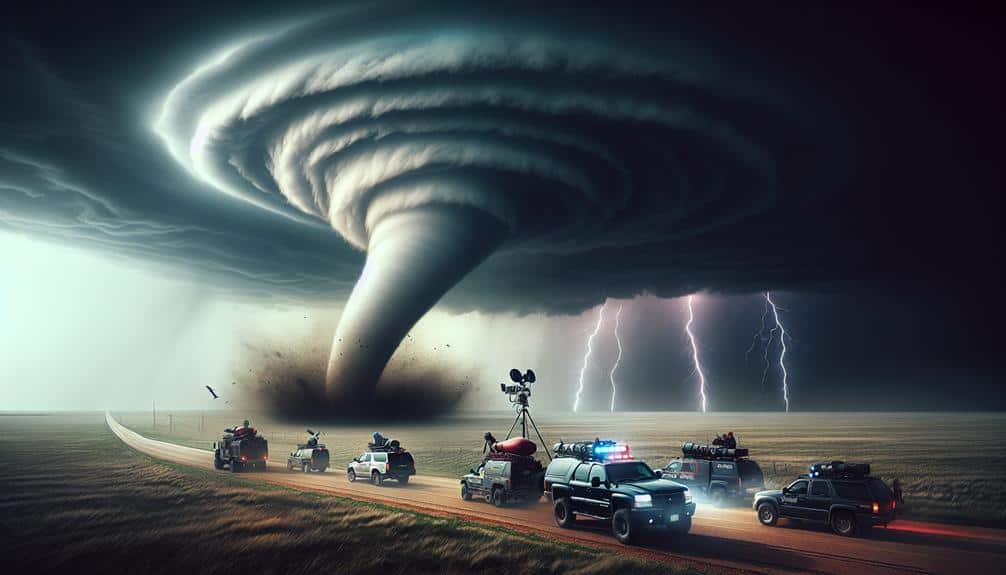In storm chasing competitions, our mental resilience is essential for peak performance and safety. Effective stress management and self-care practices, like adequate sleep and balanced nutrition, prepare us for high-pressure situations. Mindfulness and meditation boost our ability to stay focused and make quick, clear decisions amidst chaos. Techniques such as deep breathing and cognitive reappraisal help us manage stress responses, ensuring we remain composed and communicate efficiently. Emotional endurance prevents our judgments from being clouded by panic, maintaining our situational awareness. By mastering these strategies, we can thrive under pressure and conquer the most challenging conditions. Let's explore how we develop these indispensable skills.
Key Points
- Mental resilience aids in managing stress for better performance and decision-making during storm chasing.
- Effective stress management and self-care practices ensure physical and mental preparedness for high-pressure scenarios.
- Emotional regulation helps maintain composure and clear thinking when faced with unexpected challenges.
- Mindfulness and meditation improve focus and reduce anxiety, critical for situational awareness.
Understanding Mental Resilience
Mental toughness, the psychological strength to withstand and recover from stress, is vital for success in high-pressure environments like storm chasing competitions. To grasp mental toughness, we need to look at how stress management and self-care practices play key roles.
We've got to acknowledge that without proper stress management, our performance, decision-making, and overall well-being can suffer significantly. Engaging in regular self-care routines, such as adequate sleep, balanced nutrition, and physical exercise, ensures our bodies and minds are prepared for the challenges of storm chasing.
In addition to self-care, mindfulness and meditation are pivotal strategies for building mental toughness. Mindfulness helps us stay present and focused, reducing the impact of stress by allowing us to respond thoughtfully rather than react impulsively.
Handling High-Stress Situations
Building on our foundation of mental resilience, effectively handling high-stress situations requires us to employ both proactive and reactive strategies to maintain composure and make sound decisions. Proactively, stress management techniques such as deep breathing exercises and mindfulness practices can significantly reduce our physiological stress responses. These methods help regulate cortisol levels, which can otherwise impair our cognitive function during critical moments.
Reactively, emotional regulation becomes vital when unexpected variables, like sudden weather changes, arise. We can utilize cognitive reappraisal—a process of changing our emotional response by reinterpreting the meaning of a stressful situation. For example, viewing a rapidly intensifying storm not as a threat but as an opportunity to test our skills can mitigate panic and enhance decision-making capabilities.
Moreover, establishing a clear communication protocol within our team allows us to distribute tasks and responsibilities more effectively, thereby diminishing individual stress. This collaborative approach ensures that no one feels overwhelmed, enabling us to maintain a balanced emotional state.
Maintaining Focus and Clarity
Maintaining focus and clarity during storm chasing competitions demands rigorous mental discipline and the application of evidence-based cognitive strategies. Our ability to stay concentrated in the face of volatile weather conditions and high-stakes environments is non-negotiable. Research shows that cognitive distractions can be minimized through structured mental practices, which enhance our overall situational awareness and decision-making capabilities.
To maintain peak focus and concentration, we can implement the following strategies:
- Mindfulness Meditation: Engaging in regular mindfulness exercises has been shown to improve attention span and reduce anxiety, allowing us to stay present and alert during critical moments.
- Cognitive Reappraisal: This technique helps us reframe stressful situations in a way that reduces their emotional impact, thereby maintaining our concentration under pressure.
- Goal Setting: Establishing clear, concise goals for each phase of the competition can keep us focused on immediate tasks and long-term objectives, thereby preventing cognitive overload.
- Physical Conditioning: Physical fitness routines that include cardiovascular and strength training can improve our overall mental resilience, contributing to better focus and sustained concentration during prolonged storm chasing events.
Decision-Making Under Pressure
Effective decision-making under pressure hinges on our ability to quickly process information and assess risks amidst rapidly changing weather conditions. In storm chasing competitions, we face an array of unpredictable variables that demand quick thinking. Our ability to analyze meteorological data, interpret radar signals, and make swift navigational choices can mean the difference between success and failure, or even safety and danger.
Research indicates that stress management is vital in these high-stakes scenarios. Elevated stress levels can impair cognitive functions, leading to poor judgment and slower reaction times. By employing techniques such as controlled breathing and cognitive reframing, we can maintain a level of mental clarity essential for making rapid, yet accurate, decisions.
Moreover, evidence suggests that training under simulated high-pressure environments can improve our decision-making skills. Regular practice in these controlled settings enhances our cognitive flexibility, allowing us to adapt more efficiently when real-world conditions intensify. This form of preparation not only sharpens our quick thinking but also strengthens our overall resilience.
Building Emotional Endurance

To thrive in storm chasing competitions, we must cultivate emotional endurance to withstand the psychological toll of high-stress environments. Emotional endurance, or the ability to persist despite emotional strain, is essential for maintaining focus and making sound decisions under pressure. By building emotional strength and psychological toughness, we can face the unpredictable and often perilous conditions of storm chasing with confidence.
To visualize what this entails, let's consider four key aspects:
- Emotional Self-Regulation: We need to manage our emotions effectively, preventing panic or despair from clouding our judgment.
- Stress Tolerance: Developing a high tolerance for stress allows us to remain composed and operational during intense storm events.
- Resilience Training: Engaging in activities that simulate high-stress scenarios can fortify our psychological toughness, making us better prepared for real-world challenges.
- Cognitive Reframing: By changing how we perceive stressful situations, we can reduce their emotional impact, transforming potential threats into manageable challenges.
Building emotional endurance isn't just about surviving the storm; it's about thriving in it. By focusing on these areas, we can enhance our mental resilience, ensuring we stay sharp and decisive no matter what Mother Nature throws our way.
Techniques for Mental Recovery
Having established the importance of emotional endurance, we must also prioritize techniques for mental recovery to sustain long-term performance and well-being. The high-stress environment of storm chasing requires us to adopt practical strategies that promote mental resilience.
Meditation techniques, such as focused attention and body scan, can significantly reduce stress levels. By allocating just 10-15 minutes daily to meditation, we can enhance our emotional stability and improve cognitive function.
Mindfulness exercises, including mindful breathing and progressive muscle relaxation, enable us to stay grounded in the present moment, reducing anxiety and enhancing mental clarity.
Breathing techniques are another crucial component of mental recovery. Practices like diaphragmatic breathing and the 4-7-8 method help regulate our autonomic nervous system, promoting a state of calm and relaxation. Consistent use of these techniques can mitigate the physiological impacts of stress, such as elevated heart rate and cortisol levels.
Visualization methods serve as powerful tools for mental recovery. By mentally rehearsing successful outcomes and visualizing serene environments, we can foster a sense of control and preparedness. This practice not only reduces stress but also enhances our problem-solving capabilities during high-pressure situations.
Embracing these evidence-based strategies empowers us to maintain our mental health while pursuing our passion for storm chasing.
Frequently Asked Questions
How Do Storm Chasers Prepare Physically for Competitions?
We prepare for storm chasing competitions by engaging in rigorous physical training and meticulous nutrition planning. These strategies guarantee we're fit, agile, and energized, enabling us to face demanding conditions and maintain peak performance during intense weather events.
What Are the Top Safety Measures During Storm Chasing?
We always keep our eyes peeled for danger. By following strict emergency protocols and conducting thorough risk assessments, we guarantee everyone's safety. Our detailed planning gives us the freedom to chase storms without unnecessary risks.
How Do Storm Chasers Communicate During a Chase?
We rely on real-time weather updates and robust team coordination. Utilizing radios, mobile apps, and satellite phones, we guarantee seamless communication. This enables us to make informed decisions quickly, keeping us safe and effective during the chase.
What Equipment Is Essential for Storm Chasing?
Storm chasing is a high-stakes chess game; our essential gear includes advanced radar systems, GPS units, and weather radios. Safety precautions like reinforced vehicles and first aid kits guarantee we stay protected while pursuing the ultimate freedom of the storm.
Are There Specific Qualifications Needed to Enter Storm Chasing Competitions?
For storm chasing competitions, entry requirements typically include prior experience and specific qualifications. Participants must demonstrate necessary skills and training, including weather analysis and safety protocols, to guarantee they can handle the challenges safely and effectively.


